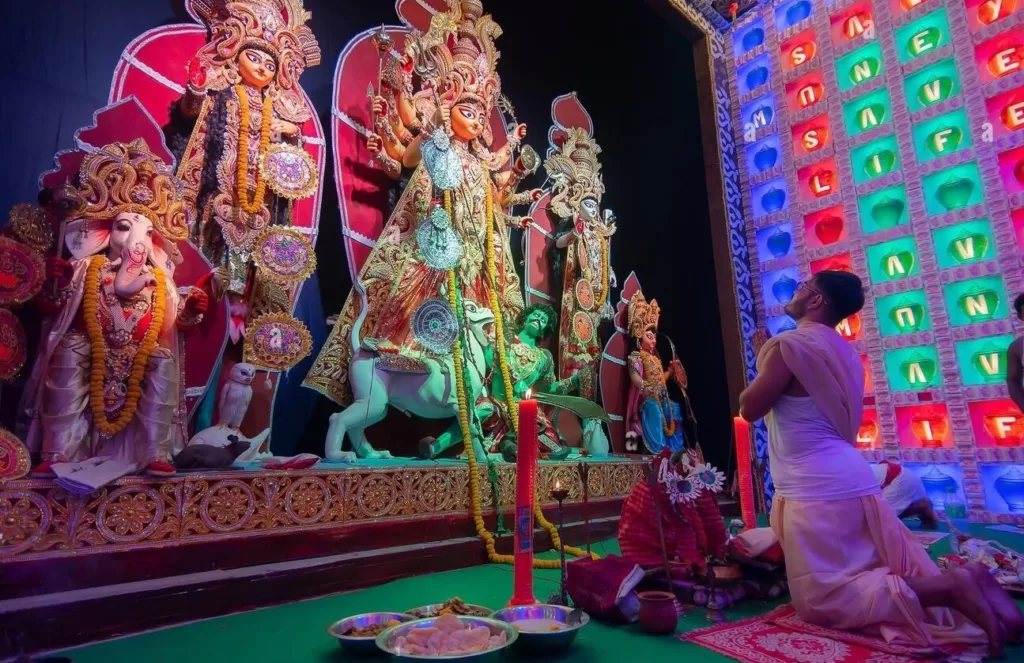Namaste! Is it only a form of greeting or a salutation? Is there more to it than meets the eye? Like most of India’s cities and towns, Indian culture is a complicated and chaotic jumble of different rites and traditions. However, a thousand years of rationality lie behind these seemingly illogical conventions and rituals, which were mistakenly believed to be antiquated, brought about by our great ancestors, sages, spiritual leaders, monks, and mahatmas to demonstrate later the enormous value-based concept in mankind ever achieved, which we often disregard due to our ignorance.

Many of the ancient Indian beliefs and practices are highly conducive to wellness. The most prominent example of a non-touch welcome nowadays is the practice of namaste. The Indian salutation “Namaste” has gained recognition beyond linguistic and geographical borders. During the covid pandemic “Namaste” became the most sought-after and coveted salutation action or treating for its extremely important “no-touch” action which was designed by our forefathers having divine knowledge and visions. For the time being, nevertheless, let’s investigate the significance of Namaste and Namaskar in Indian culture.
Defining Namaste
Namaste,” the salutation, is commonly used in India and some other parts of South Asia. The word “Namaste” is usually accompanied by a hand gesture as well as an audible sound. With palms touching and fingers pointing up, the hands are clasped together and held close to the chest. However, while praying or offering salutation to the almighty or the divine, the hand is often folded and brought up to the kutastha.
The kutastha is the region of the area between the two eyes( Christ consciousness), known as the third eye. You should also bend over a little while offering namaste. Bending before someone eliminates the ego from you, and you become more down to earth. When this happens, it is easier for the guru or your elders to bless you. The blessings will flow from the seventh chakra downward toward the heart chakra, where they reside and stay. These small gestures have immense meaning to them, which is why they were taught in the Gurukuls in ancient times. In the past, greetings had an inner meaning and were more than just a hand gesture.
Many thousands of years have passed since the gesture was first used. In the Rig Veda, the first of the four Vedas and a crucial Hindu text, the greetings “Namaste” and “Namaskar” are stated. This is a borrowed Sanskrit word. The word “namah” implies showing respect by bowing or bending down, and the word “te” refers to the person being addressed. Namaste is a greeting that means “I honor you” in Sanskrit. When taken together, the word and gesture have a greater meaning.
“The divine in me recognizes and honors the divine in you. What is holy to me is holy to you.”
These sentences, however, have been scrawled in haste across countless t-shirts and totes. Then I reflected on how the original intent of Namaste had been lost in modern usage.
Folding one’s hands is a motion with its own meaning. Hrdayanjali mudra, which translates to “reverence from the heart,” and Atmanjali mudra, which translates to “reverence from the soul,” are the Sanskrit names for this gesture. The greeting shows both modesty and respect. By saying “Namaste,” we are honoring the other person and ourselves as divinely created beings. In this way, we can put aside our pride and ego to form a genuine bond with the other person out of gratitude and love. Look at how lovely it is!
In Yoga, the fingertips are considered powerful energy centers. Each fingertip is a symbol of a different kind of power. The thumb represents the ultimate soul (or Paramatma), while the index finger represents the individual soul. The little finger represents Tamas, or dullness, while the ring finger represents Rajas or activity. Therefore, a sense of peace and well-being is experienced when the fingers are interlaced.
Significance of Namaste according to Spiritual Essence

In Indian spirituality, the gesture of joining both hands and bringing them up to the forehead between the two eyebrows holds deep significance and is known as “Namaste” or “Pranam.” This gesture is a common form of greeting and reverence in various spiritual and cultural practices across India. It symbolizes a profound understanding and recognition of the divine presence within oneself and others. Here’s a detailed explanation of the significance behind this gesture:
Unity and Equality:
When we join our hands together, it represents the merging of the individual self with the universal consciousness. It is a reminder that we are all interconnected and part of the same divine energy. By bringing the hands to the forehead, we acknowledge the divine presence within ourselves and others, recognizing the inherent equality and oneness of all beings. This gesture promotes a sense of unity, respect, and humility.
Balance and Harmony:
The space between the two eyebrows is believed to be the location of the Ajna chakra or “third eye,” chakra, which is associated with intuition, insight, and higher consciousness. By bringing the hands to this point, we symbolically activate and awaken this spiritual center. This gesture helps to bring balance and harmony to our thoughts, emotions, and energy. It is a way of directing our focus inward, quieting the mind, and seeking inner peace.
Respect and Reverence:
The act of bowing the head while bringing the hands to the forehead signifies respect and reverence towards the divine within oneself and others. It is a way of acknowledging the inherent divinity and sacredness of all beings. This gesture serves as a reminder to approach each other with kindness, compassion, and a sense of sacredness. It is an expression of gratitude and appreciation for the presence of the divine in our lives.
Cultivating Presence and Mindfulness:
The Namaste gesture is also a powerful tool for cultivating presence and mindfulness. By bringing our attention to the present moment and acknowledging the divine within ourselves and others, we become more aware and centered. It helps us let go of distractions, worries, and judgments, allowing us to connect with our inner essence and experience a deeper sense of peace and stillness. This gesture serves as a constant reminder to live with awareness, compassion, and spiritual consciousness in our daily interactions.
Overall, the gesture of joining both hands and bringing them up to the forehead between the two eyebrows in Indian spirituality represents unity, equality, balance, respect, reverence, and mindfulness. It is a beautiful way to honor the divine within ourselves and others, fostering a deeper connection with the spiritual aspect of life and promoting harmony and compassion in our relationships and interactions.
Significance of Namaste according to the Yoga system
According to the yoga system, Namaste holds profound significance and is considered more than just a greeting or gesture of respect. It encompasses spiritual, philosophical, and energetic aspects that align with the principles and practices of yoga. Here’s a detailed explanation of the significance of Namaste in the context of yoga:

Recognition of the Divine:
Namaste is a way of acknowledging and honoring the divine spark or essence within oneself and others. In yoga philosophy, it is believed that we are all interconnected and share a common divine consciousness. By joining the hands at the heart center and bowing the head, we recognize and honor this divine presence, fostering a sense of unity and reverence.
Union of the Individual and Universal Self:
Yoga seeks to unite the individual self (jivatman) with the universal self (paramatman). The gesture of namaste represents this union. When we bring our hands together, we symbolize the merging of the left and right sides of the body, which corresponds to the dualistic nature of existence. By bringing the hands to the forehead, we activate the Ajna chakra, the seat of higher consciousness, symbolizing the union of individual awareness with universal awareness.
Cultivation of Mindfulness:
Namaste serves as a reminder to be present at the moment and cultivate mindfulness. As we bring our attention to the gesture and the intention behind it, we become more aware of our thoughts, emotions, and energy. It helps us cultivate a state of mindfulness, where we observe and acknowledge our inner state without judgment. This awareness and mindfulness are essential aspects of the yogic path, leading to self-realization and spiritual growth.
Expression of Gratitude and Surrender:
Namaste also signifies gratitude and surrender. By bowing the head, we express humility, surrendering the ego and any sense of separation. It is an act of surrendering to the divine and recognizing that we are part of a larger cosmic order. The gesture represents an attitude of gratitude for the teachings, experiences, and opportunities for growth that yoga provides. It is a way of expressing thankfulness for the practice and its transformative power.
Though Namaste within the yoga system represents the recognition of the divine within oneself and others, the union of the individual and universal self, the cultivation of mindfulness, and the expression of gratitude and surrender, It also serves as a reminder to honor the sacredness of life, foster unity and reverence, and deepen one’s spiritual journey. By embracing Namaste, practitioners can bring these profound qualities and intentions into their yoga practice and daily lives, fostering a deeper connection with themselves and the world around them.

What the ancient tradition of Vedanta has to say about namaste:
In its broadest sense, a namaste is a social exchange. When people first meet, they typically exchange greetings. It’s a way to show appreciation for each other and convey joy at seeing each other. This early warmth paves the way for a fruitful friendship or romantic partnership. The greeting of Namaste, then, is a patchwork of actions and words that together hint at positive feelings and ideas. As an approach mechanism in human culture, it is rich with symbolic meaning on multiple levels. According to one explanation of namaste, the knifelike position of the hands symbolizes a desire to bypass superficial distinctions and instead focus on the fundamental similarities that unite individuals throughout civilizations.
Namaste is composed of two Sanskrit syllables, “namah” and “te.” Namah signifies an obeisance, a reverent greeting, or adoration. Te, however, means ‘to you.’ Namaste therefore literally translates to “I bow to you.” According to the Sanskrit language, the letter is used to join the words nama and te.
- To stoop
- To bow
- To slant
All of them indicate a willingness to completely and humbly devote oneself to another. In addition, the root ‘nama’ is neuter, which will have crucial ramifications that we’ll get into later.
Another meaning according to the Vedas, Nama can be broken down into its component parts, na and ma. Na means not at all, while ma means it’s mine. ‘Not mine’ would then be the implication. The ‘I’ has absolutely no exclusive possessions. Therefore, Namaste is the essential rejection of “I” and all forms of egotism. The ‘ma’ in nama is supposedly symbolic of spiritual death, while the omission of this (na-ma) confers eternal life.
The full meaning of namaste is revealed across three stages: the mind, the body, and the spoken word.
Mental surrender is the first step. This is similar to the bhakti that one shows to their god or goddess. It is claimed that the devotee would gain the traits of the person or deity to whom he offers entire adoration and subjection.
In the ancient writings known as Agamas, it is prescribed that the worshiper of a deity must first become divine himself, lest the worship as a transaction is rendered null and void. Only two people with anything in common, or “equals,” may make a deal. Therefore, we acknowledge the holy spark in another person by offering a namaste to them. Namaste not only helps us absorb these heavenly attributes, but it also opens our eyes to the ways in which we already possess them. Namaste, to put it simply, suggests:

The Holy Spirit within me is friendly with the Holy Spirit within you.
In other words, it upholds the sanctity of all life and respects the inherent worth of every individual.
In the second step. Namaste, when performed physically, is laden with profound meaning. First, when reciting namaste, it’s important to make sure the five fingers on your left hand are perfectly interlaced with the five fingers on your right. The meaning of this seemingly insignificant action controls our entire dynamic existence. The five fingers on the left hand stand for the karmendriyas, or senses of action, and the five fingers on the right hand represent the jnanendriyas or the centers of intellect. Therefore, it implies that our actions, or karma, should be in sync with one another and guided by truthful knowledge so that we make the appropriate decisions.
The ritual of Namaste is a binding symbolic act. This spiritual deed beautifully illustrates the synthesis that can occur when polarities are brought together. Namaste symbolizes the peaceful settlement of antagonistic tensions by bringing together the two hands, just as a marriage is a physical embodiment of the duality inherent in nature. Thus, namaste, which represents the secret of this unity, is the key to preserving life’s delicate balance and entering the zone where health, harmony, peace, and happiness abound.

Durga Puja, in this context, is a festival honoring the triumph of devotion over arrogance, divine love over worldly ego, and dharma over adharma. When attempting to kill Lankesh Ravana, Purushottam Rama was the first to pray to Devi Durga in her Katyayani-roopa form. Without invoking Her, Rama would not have been able to slay Ravana and free His bride Seeta from his demonic grasp. Ravana was the shishya (student) of none other than Lord Brahma. Since Durga Puja was originally celebrated during the spring Navaratri, this invocation is seen as inappropriate. Known as Basanti Puja (‘basanta’ means spring in Sanskrit), it is still held, albeit on a smaller scale, in certain areas of the delta. Akaal bodhon, which literally means “an untimely invocation,” is the name of the more famous autumn festival that occurs when Bhagavan Rama is claimed to have invoked her upon Tretayuga.
Namaste represents the form of Ardhanarishvara, which represents Shiva and Parvati’s marriage or the union of the universe’s progenitors, in this context.
Shiva’s cherished wife is an actual part of his anatomy in this guise. Parvati has achieved the perfect, prototypical union with her husband by merging into his body. Which partnership is more committed than the one that can only feel whole by becoming one? Parvati counteracts Shiva’s destructive nature by fusing her creative energy with his.

In the final stage, the namaste gesture is accompanied by a verbal sound. It is also distinctive in that its physical performance is accompanied by the verbal expression “Namaste.” This practice is equivalent to mantra recitation. It is believed that the sacrosanct sound ‘namaste’ has a quasi-magical quality, corresponding to a change in creative energy. This transformation involves harmonizing oneself with the vibration of the other.
Disclaimer: The author’s views are his or her own. The facts and opinions in the article have been taken from various articles and commentaries available in the online media and Eastside Writers does not take any responsibility or obligation for them.
Note: Contact our Writers at www.eastsidewriters.com for writing Blogs/Articles on any niche. We have experts in various domains from Technology to Finance and from Spirituality to Lifestyle and Entertainment.






